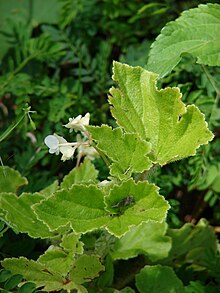Begoniaceae
| Begoniaceae | |
|---|---|

| |
| Begonia hirtella | |
| Scientific classification | |
| Kingdom: | Plantae |
| Clade: | Tracheophytes |
| Clade: | Angiosperms |
| Clade: | Eudicots |
| Clade: | Rosids |
| Order: | Cucurbitales |
| Family: | Begoniaceae C.Agardh[1] |
| Genera | |

| |
| Range of the family Begoniaceae | |
Begoniaceae is a family of flowering plants with two genera and about 2040 species[2] occurring in the subtropics and tropics of both the New World and Old World.[3] All but one of the species are in the genus Begonia. There have been many recent discoveries of species in the genus Begonia, such as Begonia truncatifolia which is endemic to San Vincente, Palawan. B. truncatifolia is smaller than other species of the genus Begonia and this new species is proposed Critically Endangered by standards set by the IUCN.[4] The only other genus in the family, Hillebrandia, is endemic to the Hawaiian Islands and has a single species.[5] Phylogenetic work supports Hillebrandia as the sister taxon to the rest of the family.[5] The genus Symbegonia was reduced to a section of Begonia in 2003, as molecular phylogenies had shown it to be derived from within that genus.[6] Members of the genus Begonia are well-known and popular houseplants.
-
Begonia flowers
-
Begonia leaves are very varied in shape and varigation.
-
The plants of many species of Begonia are covered with fine hairs.
-
The back of the leaves is one of the key points to appreciate Begonia.
-
The back of the leaves is one of the key points to appreciate Begonia.
Characteristics
[edit]Begonias, particularly double begonias,[7] have similarities to roses and have been called "Roseform Roses"[8] or simply referred to as a type of rose.[9][10]
References
[edit]- ^ Angiosperm Phylogeny Group (2009). "An update of the Angiosperm Phylogeny Group classification for the orders and families of flowering plants: APG III". Botanical Journal of the Linnean Society. 161 (2): 105–121. doi:10.1111/j.1095-8339.2009.00996.x. hdl:10654/18083.
- ^ Christenhusz, M. J. M. & Byng, J. W. (2016). "The number of known plants species in the world and its annual increase". Phytotaxa. 261 (3). Magnolia Press: 201–217. doi:10.11646/phytotaxa.261.3.1.
- ^ Laura Lowe Forrest, Mark Hughes & Peter M. Hollingsworth (2005). "A phylogeny of Begonia using nuclear ribosomal sequence data and morphological characters". Systematic Botany. 30 (3): 671–682. doi:10.1600/0363644054782297. S2CID 85909059.
- ^ Bustamante, Rene Alfred Anton; Tandang, Danilo N.; Pranada, Mc Andrew K.; Ang, Yu Pin (2020-09-04). "Begonia truncatifolia (Begoniaceae, section Baryandra), a new species from Palawan Island, the Philippines". Phytotaxa. 458 (3): 215–222. doi:10.11646/phytotaxa.458.3.4. ISSN 1179-3163. S2CID 225332921.
- ^ a b Wendy L. Clement; Mark C. Tebbitt; Laura L. Forrest; Jaime E. Blair; Luc Brouillet; Torsten Eriksson; Susan M. Swensen (2004). "Phylogenetic position and biogeography of Hillebrandia sandwicensis (Begoniaceae): a rare Hawaiian relict". American Journal of Botany. 91 (6): 905–917. doi:10.3732/ajb.91.6.905. PMID 21653447.
- ^ L. L. Forrest & P. M. Hollingsworth (2003). "A recircumscription of Begonia based on nuclear ribosomal sequences". Plant Systematics and Evolution. 241 (3–4): 193–211. Bibcode:2003PSyEv.241..193F. doi:10.1007/s00606-002-0033-y. S2CID 26838959.
- ^ "Types of Begonias". www.longfield-gardens.com. Retrieved 2022-05-27.
- ^ "Begonia 'Roseform Rose'". Gardenia.net. Retrieved 2022-05-27.
- ^ "Surefire® Rose Begonia". Plant Addicts. Retrieved 2022-05-27.
- ^ "Begonia Rose ( Rose Begonia )". Backyard Gardener. 2016-09-18. Retrieved 2022-05-27.
Further reading
[edit]- Plana, Vanessa (2003). "Phylogenetic relationships of the Afro-Malagasy members of the large genus Begonia inferred from trnL intron sequences". Systematic Botany. 28 (4): 693–704. doi:10.1043/02-56.1 (inactive 1 November 2024).
{{cite journal}}: CS1 maint: DOI inactive as of November 2024 (link)
External links
[edit] Media related to Begoniaceae at Wikimedia Commons
Media related to Begoniaceae at Wikimedia Commons






